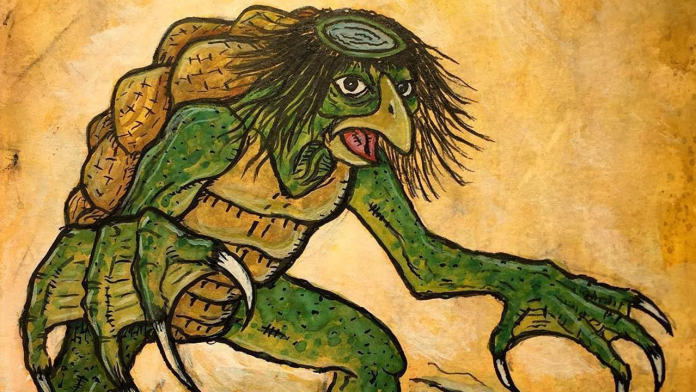In the Western world, we have a canon of monsters and ghouls that we are used to. While folklore and stories of monsters have been passed down from generation to generation across Europe and into North America, only a handful of monsters are left to be recognizable to most people. Variety YouTuber JJ McCullough recently did a poll to decide what the most recognizable monsters are in the West. However, in Japan, there exists an entirely different canon of recognizable monsters. So let’s talk about Japanese monsters.
Kappa
The kappa may be the most well-known of Japanese monsters. They are said to be roughly humanoid in form and about the size of a small child, inhabiting the ponds and rivers of Japan.
They are typically greenish in color and are either scaly or slimy skinned, with webbed hands and feet and a turtle-like shell on their backs. Known traits bizarrely include the creature having three anuses that allow them to pass three times as much gas as humans. Despite their size, they are said to be physically stronger than a grown man.
Kappa are mischievous troublemakers. Their actions range from minor annoyances like looking up a woman’s kimono to outright malevolence, such as drowning animals, kidnapping children, raping women, and eating humans. While younger kappa are frequently found in family groups, adult kappa live solitary lives. However, it is common for kappa to befriend other spirits and sometimes even people.
It’s also believed that the cucumber is their traditional favorite meal. This claim is where the name “kappa rolls” comes from, as they are sushi rolls with cucumber. In mythology, it has been said that the best action you can take to repel a kappa is by farting on it.
Tengu
Literally translated as “heavenly dog” or “heavenly sentinel,” the tengu is a type of legendary creature found in various Japanese folk religions. Depending on who you ask, they’re said to be a type of yokai (specter) or Shinto god.
Tengu have been depicted in many ways across the centuries, but they normally appear as being somewhere between a large, monstrous bird and a wholly anthropomorphized being, often with a red face or an unusually large or long nose. They were originally thought to take the forms of birds of prey and monkey deities. It is thought that Tengu’s defining characteristics in the popular imagination came from a sun god, Sarutahiko, who was a sun god worshiped in minor religions.
The tengu’s unpleasant image continued to erode in the 17th century. Some stories now present them as less malicious spirits, protecting and blessing Buddhist shrines, while some stories depict Tengu as menacing or setting shrines on fire. Tengu are difficult to spot and get rid of. According to a legend in the 18th-century, in the Kaidan Toshiotoko, a tengu took the form of a mountain hermit and faithfully served the abbot of a Zen monastery until the man guessed the tengu’s true form. The tengu’s wings and huge nose then reappeared. The tengu requested a piece of wisdom from his master and left, but he continued, unseen, to provide the monastery with miraculous aid.
Tsukumogami
In Japanese folklore, tsukumogami or “tool kami” are everyday household objects that have acquired a kami or spirit, who then possesses them. According to an annotated version of The Tales of Ise (titled Ise Monogatari Shō), there is a theory originally from the Onmyōki that foxes and tanuki, among other beings, have lived for at least a hundred years and end up inhabiting these tsukumogami. In modern times, the name can also be written as 九十九神, translating to “ninety-nine kami”, to emphasize the age of these haunted objects.
According to Komatsu Kazuhiko, an anthropologist, the idea of a tsukumogami, or a yōkai of objects, spread across the island mostly in the Middle Ages and declined in more recent generations. This was probably because household objects over 100 years old became more and more common. Komatsu infers that despite the depictions in the late 1800s art leading to a resurfacing of the idea, these were all produced in an era cut off from any actual belief in the idea of tsukumogami.
Because the term has been applied to several different concepts in Japanese folklore, there remains some confusion as to what the term actually means. Today, the term is generally understood to be applied to virtually any object “that has reached its 100th birthday and thus become alive and self-aware.” Most depictions of tsukumogami in popular media include objects such as umbrellas or walls.
Hitotsume-kozō
Hitotsume-kozō are a type of yokai that take on the appearance of a small bald-headed child with one eye, similar to a cyclops.
They generally do not cause any injury, are said to suddenly appear and surprise people, and are said to be a harmless, albeit annoying, type of yōkai. Because they don’t perform bad deeds, when they are depicted in pictures, they are often depicted with a cute or humorous design.
They are known to take on the appearance of a monk in training. This can be explained by a theory that they come from the yōkai from Mount Hiei, the ichigan hitoashi hōshi–a one-eyed, one-footed Buddhist priest said to be what the 18th Tendaizasu, Ryōgen turned into. See also Hitotsume-nyūdō.
Hitotsume-kozō are sometimes depicted carrying tōfu as a snack. Although originally, according to the yōkai researcher Katsumi Tada, Hitosume-kozo are supposed to hate anything to do with beans because of the pun “mametsubu (豆粒, bean pieces)” and “mametsu (魔滅, sound health)”. However, over time, the depictions of hitotsume-kozō started showing them carrying around Tofu, notably made from soybeans, and noting that it was their favorite food. Additionally, they are said to be related to the tōfu-kozō.
Oni
Depictions of yokai oni vary widely across history, but they are usually portrayed as being hideous, gigantic ogre-like creatures with a single horn (or multiple horns) emerging from their heads, with sharp claws, wild hair, and fang-like tusks.
They are often depicted wearing tiger-skin loincloths and carrying iron clubs called kanabō (金棒). This image actually leads to a saying in Japanese: “oni with an iron club,” meaning to be invincible or undefeatable.
Their skin may be any number of colors, but red, blue, and green are particularly common. However, they may sometimes also be depicted as black-skinned or yellow-skinned. They may also occasionally be depicted with a third eye on their forehead, or extra fingers and toes.
There’s a traditional custom to drive out evil Oni: bean-throwing. The custom is practiced during the Setsubun festival in February. It involves people casting roasted soybeans indoors or out of their homes and shouting “Oni wa soto! Fuku wa uchi!” or “Oni go out! Blessings come in!”
Kitsune
Kitsune, which literally translates to “fox”, are intelligent foxes that possess paranormal abilities that get more powerful as they get older and wiser. According to folklore, all foxes in fact have the ability to shapeshift into human form. Kitsune’s abilities range, while some folktales speak of kitsune shapeshifting to trick victims, other stories portray them as faithful guardians, friends, and lovers.
Folktales from China are the most likely origin of the Kitsune myth, as fox-like spirits appear in a variety of East Asian cultures. Stories tell of fox spirits called húli jīng that may have up to nine tails. These fox spirits were adopted to Japanese culture through merchants as nine-tailed foxes. Many of the earliest surviving stories are recorded in the Konjaku Monogatarishū, an 11th-century Japanese collection of Japanese, Chinese, and Indian literary narratives.
Japanese mythology is widely diverse and influenced from all parts of East Asia, from China to Korea to the Mariana Islands. Through word of mouth and ancient customs, many traditions and the Japanese monsters that go with them have been preserved for hundreds of years. Just as much as our Western monsters are popularized and preserved through media, such as movies and games, so too are Japanese monsters. Keen eyes will notice tropes and stories inspired by and including these mythical creatures in video games and anime.
What do you find most interesting about Japanese monsters? Let us know in the comments below or on Twitter!



